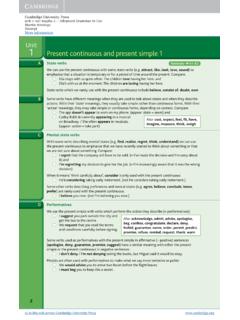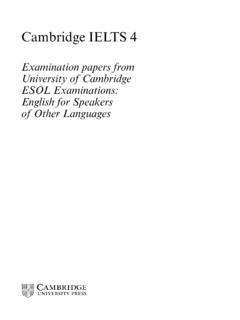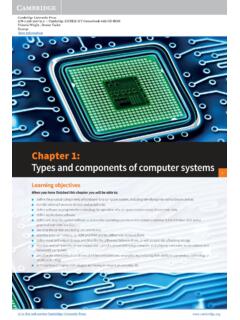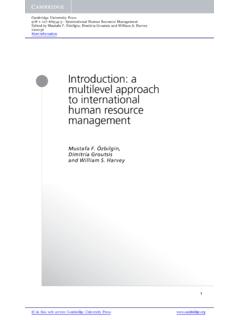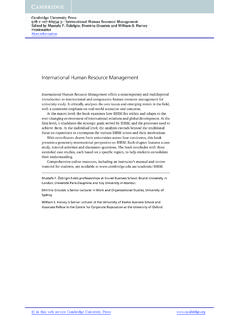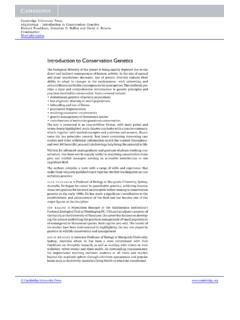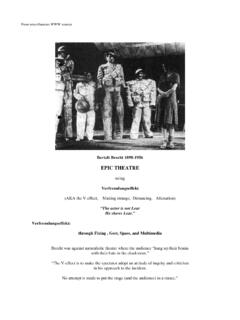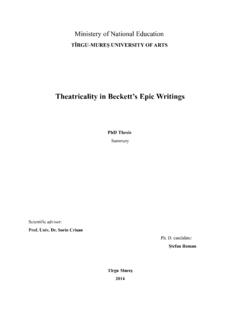Transcription of Edited by Tracy C. Davis and Thomas Postlewait
1 TheatricalityEdited byTracy C. Davis and Thomas Postlewait The Pitt Building, Trumpington Street, Cambridge, United Kingdom The Edinburgh Building, Cambridge, CB2 2RU, UK40 West 20th Street, New York, NY 10011 4211, USA477 Williamstown Road, Port Melbourne, VIC 3207, AustraliaRuiz de Alarc on 13, 28014 Madrid, SpainDock House, The Waterfront, Cape Town 8001, South Cambridge University Press 2003 This book is in copyright. Subject to statutory exceptionand to the provisions of relevant collective licensing agreements,no reproduction of any part may take place withoutthe written permission of Cambridge University published 2003 Printed in the United Kingdom at the University Press, CambridgeTypefacePlantin 10/12 [ ]A catalogue record for this book is available from the British LibraryLibrary of Congress Cataloguing in Publication dataTheatricality / Edited by Tracy C.
2 Davis and Thomas cm. (Theatre and performance theory)Includes bibliographical references and 0 521 81269 0 ISBN 0 521 01207 4 (paper back)1. Theater. 2. Theater and society. I. Davis , Tracy C., 1960 II. Postlewait , Thomas . III. 2003 792 dc21 2003053190 ISBN 0 521 81269 0 hardbackISBN 0 521 01207 4 paperbackContentsList of illustrationspageviiiAcknowledgmentsixNo tes on contributorsx1 theatricality : an introduction1 . 2 Performing miracles: the mysterious mimesis ofValenciennes (1547)40 3 theatricality in classical Chinese drama65 4 theatricality and antitheatricality in renaissanceLondon90 5 theatricality and civil society127 . 6 Defining political performance with Foucault andHabermas: strategic and communicative action156 7 theatricality s proper objects: genealogies ofperformance and gender theory186 List of works The Miracle of the Loaves and the , Twelfth Day.
3 Biblioth`equenationale, Collection J. de Rothschild ,fol. Bastille Day 1790 celebration in the Champs deMars (F ed eration G en erale Faite `a Paris, le 14 Juillet1790).Collection compl`ete des tableaux historiquesde la r evolution fran caise, Paris: Chez Auber, of Northwestern University theatricality : an introductionThomas Postlewait and Tracy C. DavisOne thing, but perhaps only one, is obvious: the idea of theatri-cality has achieved an extraordinary range of meanings, makingit everything from an act to an attitude, a style to a semiotic sys-tem, a medium to a message. It is a sign empty of meaning; itis the meaning of all signs. Depending upon one s perspective, itcan be dismissed as little more than a self-referential gesture orit can be embraced as a definitive feature of human communica-tion.
4 Although it obviously derives its meanings from the worldof theatre,theatricalitycan be abstracted from the theatre itselfand then applied to any and all aspects of human life. Even iflimited to theatre, its potential meanings are daunting. Thus,it can be defined exclusively as a specific type of performancestyle or inclusively as all the semiotic codes of theatrical repre-sentation. Some people claim that it is the definitive conditionor attitude for postmodern art and thought; others insist that italready achieved its distinguishing features in the birth of mod-ernism. Within modernism, it is often identified as the oppositeof realism, yet realism is also seen as but one type of , it is a mode of representation or a style of behavior charac-terized by histrionic actions, manners, and devices, and hence apractice; yet it is also an interpretative model for describing psy-chological identity, social ceremonies, communal festivities, andpublic spectacles, and hence a theoretical concept.
5 It has evenattained the status of both an aesthetic and a philosophical sys-tem. Thus, to some people, it is that which is quintessentially thetheatre, while to others it is the theatre subsumed into the wholeworld. Apparently the concept is comprehensive of all meaningsyet empty of all specific recent times, scholars across the arts, humanities, and so-cial sciences (and journalists of every stripe) have invoked the12 Thomas Postlewait and Tracy C. Davispositive and negative valences of the idea of theatricality in somany cases and contexts that its connotations now seem almostlimitless. Deciphering its possible meanings has become a majorchallenge, and occasionally an impossibility, because this expan-sive idea engages some of the most pressing issues of our age:the aspects and nature of performance, the history of aestheticstyles, the means and modes of representation, the communica-tive power of art and artistry, the formation of subjectivity, andthe very operations of public life (from politics to social theory).
6 Given these contending meanings, it is crucial that we be able todiscern what is meant when a writer uses the term theatricality , but far too often we are confronted with vague definitions, un-specified parameters, contradictory applications, and tautologi-cal reasoning. Hence, the meaning of theatricality cannot betaken for order to understand why there are so many meanings andapplications, it greatly helps to investigate the history of the ideaof theatricality . Although the word itself has a short history (inEnglish, for example, it was coined in 1837), its possible deno-tations and connotations connect it with terms, concepts, andpractices that have a long history in many cultures. So, whatis often called theatricality today has gone by various names inthe past.
7 Or we might say that various concepts and practiceshave often struggled toward a name which has remained elu-sive. Our task, then, is to understand how and why these otherthings, in their successive applications, have been conceived andreconceived as theatricality . Sometimes, for example, theatrical-ity has been identified with both the Greek idea ofmimesisandthe Latin idea oftheatrum mundi. Neither concept carries exactlythe same meaning as the idea of theatricality (as we will attemptto illustrate), yet bothmimesisandtheatrum mundi, as terms andconcepts, contribute to the ways we understand (and misunder-stand) theatricality . Appearing and reappearing throughout theages, these terms and concepts continue to color the meaningsof theatricality in our , rather than confining theatricality within its etymologicalhistory in English or any language, we find it more useful toexamine the concepts and practices which it invokes.
8 Each ofthese concepts and practices has a history; it comes from some-where, each in its own time, and then it develops and modifiesTheatricality: an introduction3over time. As attributions change and are succeeded by new ormodified ones, concepts and practices complicate each other,resulting in the tangled complementarity and contradictionsthat are accorded to theatricality today. Though we are greatlyconcerned with the emergence and use of the term theatrical-ity in the last two centuries when the word itself has beenasked to do so much work we are also interested in how theterm and idea get appliedpost hocto earlier times, including pre-modern theatres and societies. And we are especially interestedin how the contemporary idea of theatricality partakes of topic, then, is the idea of theatricality in its various mani-festations throughout many periods, even when the term itself didnot exist.
9 In particular, as theatre scholars, we are concerned withthe relationship between the expansive meanings of theatricalityand the particular cases of theatrical activity. theatricality andtheatrical activity may seem, to some observers, to be the samething, but such is not necessarily the case. By taking historicalperspectives on the various uses and meanings of the term, wewant to show how the history of theatre and the history of the ideaof theatricality are related yet sometimes distinct , they are sometimes at odds with one this endeavor we resist the apparent need to stipulate onemeaning for theatricality . Such a definition, we acknowledge,would offer some much-needed clarity to a very confused situ-ation, but the domain of theatricality cannot be located withinany single definition, period, or practice.
10 Nor can it be limited toany one application. Moreover, to fix the meaning of theatricalitywould defeat the purpose of our project, which is to investigatethe wide range of possible applications (and misapplications). Werecognize, though, that this approach will not eliminate some ofthe ambiguities and contradictions in the meanings of theatrical-ity. But our introduction and the collected essays should identify,with historical and theoretical rigor, what some of the interpre-tive possibilities and critical problems are that pertain to the ideaof theatricality . We may fail to deliver a single definition or a sys-tematic understanding of theatricality , but we hope to challengethe ahistorical and laissez-faire uses of the concept in criticalusage today.

